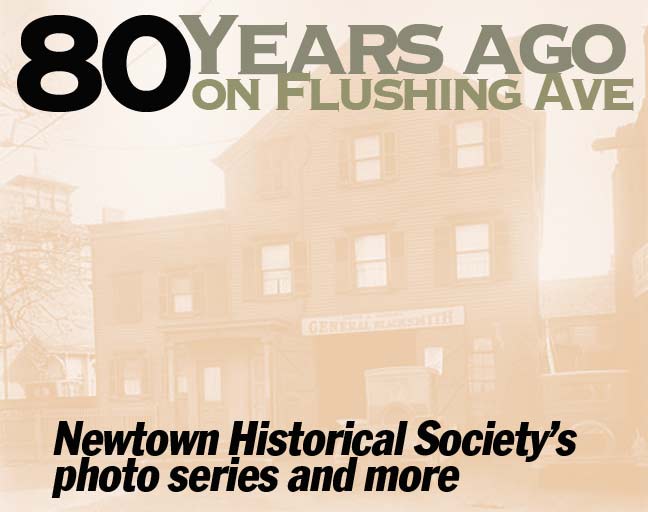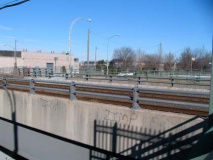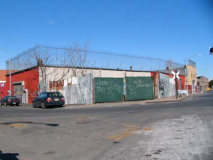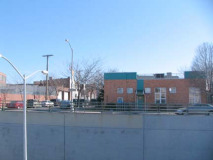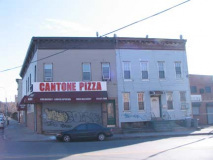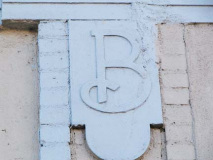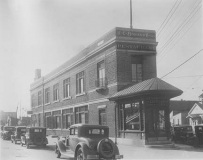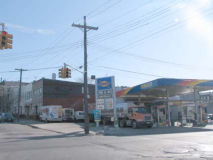Bank windows at Maspeth Federal Savings Bank at Grand Avenue and 69th Street are featuring the very first Newtown Historical Society exhibit, A Walk Down Flushing Avenue in 1929. The exhibit runs December 21, 2009 through February 27, 2010. New York in the 1920s and 1930s is surprisingly well-documented and archived — the City photographed most properties then extant, and asphalt and road paving companies routinely took photos of roadways and roadbeds during this time.
The Newtown Historical Society hopes to foster curiosity and appreciation for western Queens communities such as Maspeth, Glendale, Elmhurst, Astoria and Jackson Heights, all of which at one time were part of Newtown, a name chiefly remembered today by Newtown High School and the Grand Avenue-Newtown station on the IND Queens Boulevard line. Newtown, originally centered around today’s intersection of Grand Avenue and Broadway, was founded as Middleburgh in 1652 by Dutch colonists who had been forced east from Mespat (toady’s Maspeth) by Native American attacks. The British renamed the town Newtown in 1664, when Britain took over New Amsterdam and surrounding communities from the Dutch, to differentiate it from the earlier settlement. Eventually Newtown encompassed most of western Queens, as this 1873 Beers Atlas plate shows. The old Newtown town center was renamed Elmhurst by the Cord Meyer development company in 1896 to promote new housing being built in the region. After Queens’ consolidation into NYC in 1898 Newtown/Elmhurst eventually became part of the Long Island City postal district.
As noted in FNY’s page on Flushing Avenue, Long, Hard Road, Flushing Avenue was originally opened from the Brooklyn Navy Yard to Bushwick Avenue between 1805 and 1850 as a toll road, the Brooklyn and Newtown Turnpike, and took a curving route east through hilly land as it was gradually extended through to Grand Avenue in Maspeth. By 1893 the hills were leveled, the road straightened, and Flushing Avenue assumed its current name. It is so-called because it originally led to wagon and cart trails that crossed the swamps of what is now Flushing Meadows-Corona Park to the town of Flushing.
Here’s a sampler of what you will find in the bank windows, as well as a few extras tossed in.
2146 Flushing Avenue was likely a little east of Metropolitan Avenue. This section of Queens has a rather confusing house numbering system — some sections conform to the Brooklyn numbering, in the 1700s through 2100s, and the rest — mostly north of Metropolitan Avenue — to Queens’, which hues to the street numbers. 2146 likely later carried a house number in the 50-00s. Note the bluestone sidewalks, Belgian-blocked street, and lack of a curb. The #57 streetcar line would run on Flushing Avenue until 11/28/48, when it was replaced by the B57 bus. This building has likely either been demolished, or its detail long-hidden under aluminum siding.
A. Grede Fine “Footware” for Ladies and Gents occupied the ground floor. In a 2nd floor window we see a campaign poster for Edward W. Cox, the Democratic challenger for Queens Borough President. Cox would lose to incumbent Republican Beep George Upton Harvey in 4 days after the photo was taken, November 5, 1929.
Just before leaving office in 1941, Harvey welcomed Civic Virtue to Queens Borough Hall — the Frederic MacMonnies work depicting a warrior standing victoriously over two writhing mermaids had just been banished to the hinterlands from its earlier perch in City Hall Park:
“I have been kicked around for years just as the statue has. I felt that he and I had so much in common that, if he were over here, near my office, I could come out here sometimes and we could tell each other our troubles.” Central Queens Historical Association
LEFT: Melvina Pet Shop, undetermined corner on Flushing Avenue. The owner’s name, Charles Koferl, is etched on the window; in the display window are birdcages and dog collars. Posters advertising barn dances, and a campaign flyer for Edward W. Cox, can also be found in the window. An advert for a soft drink says: “Thirsty? Just Whistle!” (Whistle is an orange-flavored soft drink still sold in some parts of the USA). Niagara Dry Ginger Ale and Manhattan Special Beverage (an espresso coffee flavored drink, still produced in Williamsburg) are also represented. A graffito above the seated man reads, “I Love You.” Melvina was a small section of Maspeth in the vicinity of Flushing and Grand Avenues and 59th Street. A one-block lane called Melvina Place remembers it today.
RIGHT: Charles Schilcher (likely pronounced SKIL-ker) Café, which, judging from the paper in the window, may have been closed by the time this exposure was produced on Nov. 1, 1929. The proprietor’s name is etched in glass above the entrance. (Examples of this are now rare; Teddy’s in Williamsburg retains a “Peter Doelger’s Extra Beer” glass sign in the front window.) “Kiss me” is chalked on one of the doors.
Again, not sure where the exact location is other than it’s on Flushing Avenue. My educated guess would be the stretch between Metropolitan and Onderdonk Avenues, which to this day is lined with auto repair, scrap metal palaces and chop shops. The blacksmith was still an important player in urban areas and would continue to be well into the Roaring Twenties.
Metropolitan Greenhouse, November 1929. Not sure how long they were in business, though a listing turns up for it at 1875 Flushing Avenue (between Onderdonk and Woodward) in the November 1960 Popular Mechanics, so it lasted that long.
Flushing Avenue looking east toward Grand Avenue. SOCONY, or Standard Oil Company of New York gas stations were ubiquitous in pictures of NYC in the 1920s and 1930s. The company began as Standard Oil, a partnership developed by John D. Rockefeller, his brother William, and other players. After a number of mergers and renamings, SOCONY is now Mobil Oil. The billboards on the Grand Avenue side include those for a vaudeville theatre, Swift’s Premium ham, and Majestic and Bosh radios.
Same scene, 80 years later. Up until recently, a gas station could still be found on the triangular corner; it is now home to a drive-in bank. A few of the buildings in the far distance in the 1929 photo are still there, but in 2006 the new condos at the corner of Grand and 64th Street were built. RIGHT: new landscaping at the Flushing-Grand Avenue junction.
Flushing Avenue at 60th Lane, 1929 (right) and 2010 (left). The aluminum siding fairy has visited these attached houses in the 80 years between photos.
Flushing Avenue and 60th Place. The homes are altered, but their old outlines are still evident. The meat market on the corner in 1929 is now the Moonlight Sports Bar and Grill.
Flushing Avenue is crossed by two sets of railroad tracks, the Montauk and Bushwick Long Island Rail Road lines. While traffic was controlled by a simple set of crossing gates and a diamond-shaped warning sign in 1928, the crossing in 2010 is a little more complicated than that. In the 1960s Flushing Avenue was depressed in a traffic underpass to allow Montauk Line train traffic (mostly freight, though the line sees 2-3 passenger runs each weekday).
The freight Bushwick LIRR branch, meanwhile, runs over the depressed roadway on an iron bridge and local Flushing Avenue traffic must stop if a train is crossing at this point. In 2009, the Bushwick was somewhat upgraded with new signals, and its (usually garbage-strewn) right of way was cleaned up.
56th Street and Flushing Avenue, 1929. A closer look will reveal a street sign reading Caspian Street next to the 2nd floor window. In the early 20th Century this street was known by two names, Atlantic and Caspian; there was a trend toward an oceanic theme in the area, with adjoining streets named Pacific, Baltic, Adriatic, Artic [sic]. The borough adopted numbered streets beginning in the 1920s because some streets carried two names, while other names were duplicated in multiple neighborhoods.
On the 56th Street side, a campaign poster for alderman Joseph Dittus can be seen. The Board of Aldermen was the precursor of today’s City Council. A striped barber pole is visible on the right.
I’m unsure whether our 1929 view shows the SW or NE corner, so I’ll show both of them in this January 2010 view. Many houses were demolished during and after the placement of Flushing Avenue in an open cut, and the avenue itself has changed from mostly residential to industrial, if not desolate.
In 1929 a man and woman stand outside then-2165 Flushing Avenue, a “hotel for men,” at 54th and Flushing Avenue. A sign on the right advertises Edwards Brothers Piano Movers. An engraving at the roofline indicates it was constructed in 1905. In 2010, the brick building on the NE corner would have had to have been substantially altered if it’s our 1905 hotel — so it may have replaced our hotel. Note the Bushwick LIRR branch crossing gates at left, which tipped me that the 1929 view does show the NE corner.
A look at the 54th Street side. Very tough to say if the 1929 and 2010 buildings are one and the same.
It appears that the Flushing Avenue side was shaved off to accommmodate a street widening and this is indeed the same building, as some have informed me.
52-20 Flushing Avenue at 53rd Street, a “German restaurant and lunchroom.” Another example of the detail-oriented workmanship prevalent at this time, with fancy roof detailing and etched glass in the restaurant’s picture windows.
80 years later, the building still stands, and its age is hinted by the corbelling at the roofline, though that too has been altered since 1929. A pizzeria stands in for the German restaurant.
The H.C. Bohack Restaurant, Flushing Avenue and Troutman Street, is relatively intact since 1929 — a few of the distinctive Bohack “B’s are still there on the Flushing Avenue side.
German immigrant Henry C. Bohack opened his first grocery in 1887 and over the years Bohack’s developed into one of the first powerhouse grocery store chains. Grand Union, Key Food and all the rest were to follow. When the Depression arrived in late 1929, Bohack responded by actually opening more stores to provide employment. The founder passed away in 1930. Bohack’s prospered until 1974 when the chain went bankrupt. After an attempted merger with Shoprite failed, Bohacks disappeared into the history books in 1977. Occasionally, though, an old awning or sign is taken down and the Big B is in evidence briefly once more.
Likely the SW corner of Flushing Avenue and Woodward Avenue, at the time subtitled on maps and street signs as Woodward Street. The three-story frame building is anchored on the ground floor by a beauty parlor and barber shop.
Today the space is occupied by a Sunoco gas station.
This concludes FNY’s survey of former Flushing Avenue scenes, but remember, more information and some additional photos can be found in the bank window at Maspeth Federal Savings at Grand Avenue and 69th Street until February 27, 2010.
Prints of any of the 1929 photos can be purchased from the Newtown Historical Society. Go to newtownhistory@gmail.com or call 718-366-3715 for more information.

